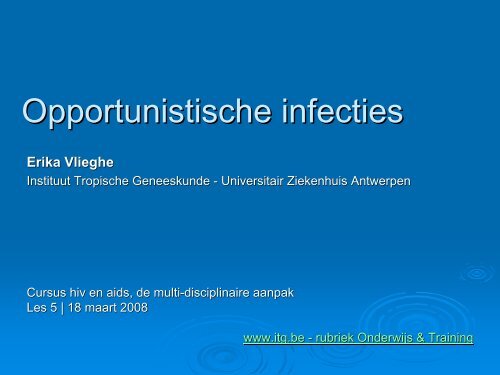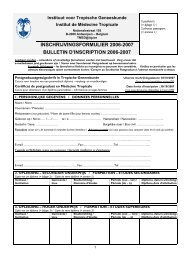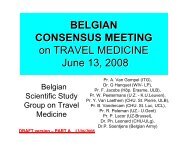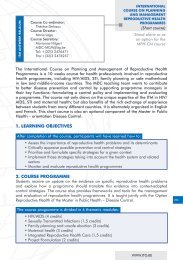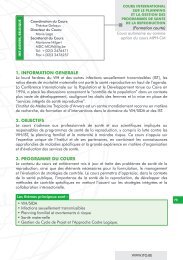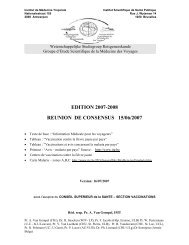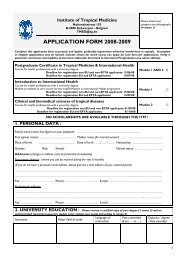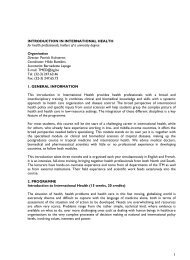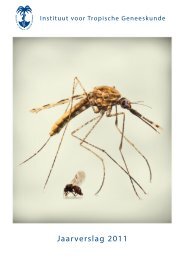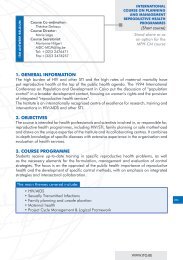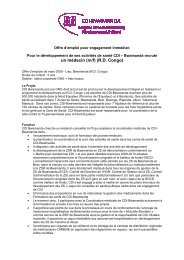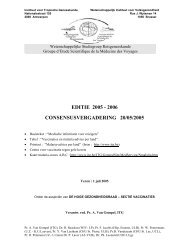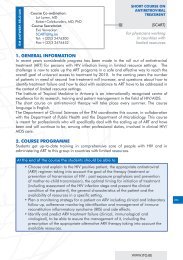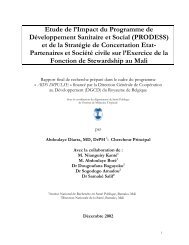HIV infectie - Itg
HIV infectie - Itg
HIV infectie - Itg
You also want an ePaper? Increase the reach of your titles
YUMPU automatically turns print PDFs into web optimized ePapers that Google loves.
Opportunistische <strong>infectie</strong>s<br />
Erika Vlieghe<br />
Instituut Tropische Geneeskunde - Universitair Ziekenhuis Antwerpen<br />
Cursus hiv en aids, de multi-disciplinaire<br />
aanpak<br />
Les 5 | 18 maart 2008<br />
www.itg.be - rubriek Onderwijs & Training
Wat zijn opportunistische <strong>infectie</strong>s?<br />
‣ OI is een <strong>infectie</strong> veroorzaakt door een<br />
micro-organisme organisme dat normaal geen ziekte<br />
veroorzaakt in een persoon met een<br />
normale immuniteit<br />
‣ Op het ogenblik van een verzwakking van<br />
het immuunsysteem wordt deze <strong>infectie</strong><br />
wel actief en levensbedreigend
30 year old teacher<br />
‣ Asymptomatic, during check up by the general<br />
practitioner found to be<br />
<strong>HIV</strong> seropositive<br />
‣ No medical follow up<br />
‣ …<br />
‣ 5 years later cough, temp 38°C<br />
‣ Chest physician: Chest X Ray normal<br />
‣ Cough syrup<br />
‣ 2 days later dyspnoea
Pneumocystis jiroveci
Op 28 AIDS aangiftes in 2005<br />
10<br />
9<br />
8<br />
7<br />
6<br />
5<br />
4<br />
3<br />
2<br />
1<br />
0<br />
PCP TB EC CMV ADC/PMLTOXO KS NHL MAC Fung<br />
Source: Erika Vlieghe (data: AIDS aangifte)
Opportunistische <strong>infectie</strong>s komen nog<br />
steeds voor ondanks HAART<br />
‣ Patiënten weten niet dat ze <strong>HIV</strong> positief<br />
zijn<br />
• Nooit laten of durven testen<br />
‣ Patiënten<br />
‘verdringen’ hun <strong>HIV</strong> diagnose<br />
• Komen laat, bij klachten<br />
‣ (Succes van HAART is 60-80%)<br />
• Therapie falen (non(<br />
non-adherence<br />
of resistentie)
<strong>HIV</strong> daling van de CD4 <br />
complicaties<br />
PREVENTIE?<br />
< 200 CD4 preventie door medicatie
Immunological staging<br />
Not significant immunosupression >500<br />
Mild immunosupression 350-499<br />
Advanced immunosup. 200-349<br />
Severe immunosup
WHO consultative meeting 1993<br />
Clinical staging of <strong>HIV</strong> in resource-<br />
limited settings, last version 2006<br />
WHO 1<br />
WHO 2<br />
WHO 3<br />
ADULTS<br />
WHO 4
Acute <strong>HIV</strong> infection (WHO stage I)
WHO stage 2
Seborrheic dermatitis
Herpes zoster<br />
(gordelroos)
Bacteriële<br />
pneumonie<br />
(klassieke<br />
longontsteking)
WHO stage 3
<strong>HIV</strong> and Tuberculosis
(Open) Long TBC
Type of TB in function of CD4 count<br />
500 CD4<br />
EARLY <strong>HIV</strong><br />
Typical Tuberculosis<br />
200 CD4<br />
50 CD4<br />
LATE <strong>HIV</strong><br />
Atypical<br />
PTB<br />
EPTB
Oral Thrush (orale(<br />
candida)<br />
Candida albicans is an<br />
endogenous yeast<br />
‣ 60% of patients per<br />
year with CD4 < 100<br />
‣ 10-20%<br />
Oesophageal<br />
candidiaisis
WHO stage IV
“Slim<br />
Disease”/Wasting
Causes of diarrhea<br />
‣ Infectious agents<br />
‣ Other causes<br />
AIDS enteropathy<br />
Kaposi’s sarcoma<br />
Lymphoma of the gut<br />
Medications<br />
Bacteria<br />
Protozoa<br />
Toxin induced<br />
Mycobacteria<br />
Helminthic<br />
Fungal<br />
Viral
‣ Typical chest X-rayX<br />
PCP, diagnosis<br />
• ‘Butterfly<br />
wings’ (25% normal!)<br />
‣ Sub-acute<br />
onset, , dry cough, , (fever(<br />
fever)<br />
‣ DYPNOEA (on(<br />
exertion)<br />
Diagnosis by<br />
clinical presentation,<br />
chest X-ray, , BAL
Casus<br />
‣ 58 jarige man<br />
‣ Bediende<br />
‣ Last om computer te bedienen<br />
‣ Hoofdpijn<br />
‣ Plotse hemi-paresis<br />
‣ Oppuntstelling CVA
Cerebral toxoplasmosis
Cerebral toxoplasmosis<br />
Cause : T. Gondii (oocysts<br />
in cat stools and<br />
undercooked meat)<br />
– invasion of lungs, heart, retinitis, brain<br />
SYMPTOMS:<br />
‣ Fever: 50%<br />
‣ Headache: 50-70%<br />
‣ Hemiparesis: : 50%<br />
‣ Seizures: 30%<br />
Diagnose : IgG, , scan, MRI (CSF normal)<br />
Response to empirical therapy
Casus 2<br />
‣ 38 jarige man<br />
‣ Homoseksueel<br />
‣ Hemiparese en abnormale beweging rechter<br />
arm<br />
‣ Traag denken<br />
‣ CT scan/MRI: multipele hypodense letsels in de<br />
witte stof van beide hemisferen<br />
‣ LP: PCR positief voor JC virus<br />
• PML: progressieve multifocale leuco-encephalopathie<br />
encephalopathie
Progressive multifocal<br />
leucoencephalopathy(PML)
Progressive Multifocal<br />
Leucoencephalopathy (PML)<br />
‣ JC virus<br />
‣ Sympt : insidious (no<br />
fever, no headache, no<br />
ICH)<br />
- Motor :Hemiparesis:<br />
Hemiparesis, hemiplegia<br />
- Visual : cortical blindness, hemianopsia dysarthria,<br />
- Cognitif : personality change, , dementia<br />
‣ Diagn: : CT Scan : multiple hypodense lesions<br />
of white matter, MRI, CSF: N (PCR: JC)<br />
‣ Prognosis : 6 M survival<br />
‣ Treatment = HAART<br />
‣ DD: lymphoma, toxo…
Casus 3<br />
‣ Homoseksuele man wordt door moeder<br />
binnengebracht op raadpleging<br />
‣ Geheugenstoornis sinds enkele maanden<br />
‣ Apathisch, komt niet meer buiten<br />
‣ Incontinent<br />
‣ Rolstoel
AIDS dementia complex
AIDS dementia Complex or <strong>HIV</strong><br />
Encephalopathy<br />
‣ Bijna 10% van de AIDS patiënten<br />
‣ Progressief over maanden<br />
‣ Gedragsstoornis<br />
‣ Motorische stoornissen<br />
‣ Geheugenstoornis<br />
‣ Exclusie diagnose<br />
‣ Normaal lumbaal vocht (JC negatief)
Cryptoccocal<br />
meningitis
AIDS related cancers<br />
‣ NHL/PCL/KS: veel frequenter in <strong>HIV</strong> + dan<br />
<strong>HIV</strong>- (60-200x)<br />
KS<br />
NHL<br />
PCL
Non-Hodgkin<br />
lymphoma
Cerebral lymphoma
Kaposi’s sarcoma
Kaposi’s sarcoma
NHL/PCL/KS<br />
‣ Geassocieerd met gamma-herpes<br />
virus<br />
(EBV, HHV-8)<br />
‣ na HAART: sterke daling in incidentie<br />
‣ maar: levensverwachting neemt toe life<br />
time risico verhoogt<br />
‣ Goede nieuws: betere overleving, met<br />
HAART, vergelijkbaar met <strong>HIV</strong> (-)(
Squamous cell carcinoma
Anal squamous carcinoma
Hoe deze OI te voorkomen?<br />
‣ Vaccinatie<br />
‣ Profylactisch antibiotica<br />
‣ Profylactisch INH<br />
‣ <strong>HIV</strong> diagnose tijdig stellen en…<br />
‣ HAART starten wanneer geindiceerd!
Incidence/year<br />
EUR/ US<br />
Cotrimoxazole<br />
> 10%<br />
PCP<br />
KS<br />
EC<br />
1-10%<br />
Incidence/year<br />
> 10%<br />
EUR/ US<br />
PCP<br />
KS<br />
EC<br />
1-10%<br />
Pneumovac<br />
Bacterial infections<br />
Chron Herpes simplex<br />
TB<br />
Toxoplasmosis<br />
cryptococcosis<br />
MAC<br />
Incidence/year<br />
EUR/ US<br />
> 10%<br />
PCP<br />
KS<br />
EC<br />
1-10%<br />
Incidence/year<br />
> 10%<br />
EUR/ US<br />
PCP<br />
KS<br />
EC<br />
1-10%<br />
INH<br />
Bacterial infections<br />
Chron Herpes simplex<br />
TB<br />
Toxoplasmosis<br />
cryptococcosis<br />
MAI<br />
Incidence/year<br />
> 10%<br />
1-10%<br />
INH<br />
Nieuwe AIDS gevallen in<br />
West- Europa<br />
30000<br />
25000<br />
20000<br />
15000<br />
10000<br />
5000<br />
0<br />
Aantal AIDS gevallen<br />
1986<br />
1987<br />
1988<br />
1989<br />
1990<br />
1991<br />
1992<br />
1993<br />
1994<br />
1995<br />
1996<br />
1997<br />
1998<br />
1999<br />
2000<br />
European Centre for the Epidemiological Monitoring of AIDS, France, 2001<br />
HAART
Syndroom van immuunreactivatie
Definition of IRIS<br />
Previously latent or incubating diseases<br />
which become symptomatic or worse<br />
after the introduction of HAART<br />
Paradoxical reaction: : worsening of<br />
symptoms of OI’s s which were already<br />
under treatment (TB, MAC, CMV),<br />
shortly after starting HAART
Susceptibility factors for IRD<br />
Antigens of opportunistic<br />
pathogens<br />
• Active infection<br />
• Subclin ical infection<br />
• Non-viable organisms<br />
IRD<br />
Disease susceptibility<br />
genes<br />
• Herpesvirus disease<br />
HLA-A2,-B44,-DR4<br />
IL12B-3’UTR*1<br />
• Mycobacterial disease<br />
TNFA-308*1<br />
IL6-174*G<br />
CD4 T-cells
En wat we verwachten is…<br />
HAART
Dank voor uw aandacht!


